Tools to Optimize Website Speed for Improved User Experience and SEO
In today’s evolving digital landscape the speed of a website is more than just a technical factor. It significantly influences the success of your online presence. The loading time of your site can affect user satisfaction, search engine standings and conversion rates. A sluggish site can frustrate users leading to bounce rates and decreased engagement. Conversely a fast loading website can keep visitors satisfied, enhance SEO performance and ultimately drive up conversion rates.

What is Website Speed?
Website speed is the time it takes for all the pages on your site to load which can significantly impact how users interact with your content and features online. Think about your browsing experiences. Have you ever left a site because it was taking too long to load? In today’s paced digital world people expect instant access to information and content online. If a website is slow to load there’s a chance that visitors will leave and not come back again. Not only does this decrease the likelihood of conversions but it also has a detrimental effect on your SEO position.
Picture yourself browsing through a store and selecting an item to view online but facing a slow loading page – frustrating isn’t it? This inconvenience could lead to missing out on a sale as the shopper might opt to exit the website due to impatience. Conversely, a fast loading website enables users to browse products swiftly, add them to their cart and efficiently finalize their purchase process without any delays., all of which leads to greater sales and more satisfied customers, in general.
Why is Site Optimization Important?
Ensuring that your website is optimized is essential, for a variety of reasons:
1. Improved User Experience
An optimized website loads quickly and facilitates user friendly navigation to help users locate the necessary information effortlessly. Happy users tend to stay longer, explore more pages and eventually transition into loyal customers or subscribers.
2. Achieving Better Search Engine Rankings
Google has always valued the speed of a website as a factor, for ranking it higher in search results. A quicker website is more likely to show up at the top of search engine listings, boost visibility and attract an amount of natural traffic.
3. Increased Conversions
Faster loading times can boost your profits by boosting conversions. Research suggests that a mere one second delay in page load time could result in a 7% drop in conversions! Speedy websites offer experiences that motivate users to engage with your content. Be it buying a product or service online signing up, for updates or submitting inquiries via forms.
According to a report from Amazon – a player in online retail – they found that a mere 100 milliseconds of delay in their operations led to a 1 percent drop in sales revenue.It goes to show how minor enhancements in speed can truly make a difference, in boosting profits.
How Does Site Speed Affect SEO?
Google introduced the speed of a website as a ranking factor in 2010 initially for computers and later extended it to mobile devices by 2018 to match the growing significance of mobile searches, in ranking evaluations. This implies that if your website is slow it could make it challenging for potential customers to find your business in search results.
Imagine two competing online stores selling products; If everything else is equal between them and if a website loads faster than the other when users search on Google the quicker site has a chance of ranking higher in search results compared to the slower site.. This minor detail might influence a customer to choose your website over your rivals.
Why Are Tools Important for Website Speed Optimization?
Improving the speed of a website can be challenging without the tools to diagnose issues and determine the level of improvement needed accurately. The correct tools offer in depth insights into your websites performance status, identify specific problems while suggesting ways to enhance speed.
These tools can be used to evaluate the performance of your website and see where it can be improved. With website performance testing tools you will get a detailed report on your website performance including:
- number of requests,
- content size,
- load time etc.
Benefits of Using Website Speed and Performance Testing Tools
Here are some key benefits of using website speed and performance testing tools:
- Analyze the speed of your website or individual pages to optimize load time for better rankings and user experience.
- Identify and fix technical issues slowing down your website.
- See how your site performs on different devices.
- Discover how long your site takes to load in various regions or countries.
Key Tools for Measuring and Optimizing Website Speed
1. GTmetrix

GTmetrix is a tool that lets you check the speed at which your website loads at no cost at all! Simply input your website URL into the designated field. Hit the “Test your site” button.
If you haven’t signed up yet and need to access the information; it might require a few minutes for the results without registration compared to when you have an account already established where the process speeds up considerably.
The tool gives information about how the website is performing in terms of speed and size of the pages on it as well as offering advice on how to make things better by organizing suggestions based on importance and urgency level, with critical problems highlighted in red or left blank for immediate action needed; if you select one of these recommendations by clicking it will show you where optimizations are required within the site.
Google’s increased emphasis on optimization has made GTmetrix unique in its ability to provide a comprehensive analysis of both speed and mobile friendliness compared to other tools such as Pingdom or Google’s PageSpeed Insights.
GTmetrix offers in depth insights into particular website speed concerns by evaluating your websites performance on a scale from F to A determined by loading time and page size metrics alongside providing practical suggestions for enhancing performance ranked by significance for you to choose from based on the level of effort and potential impact, on your website.
GTmetrix has a function that reveals the culprit behind particular problems such as issues related to servers – making it easier for you to pinpoint the cause of delays in your website’s performance. If server related troubles are detected through this feature you might have to reach out to your hosting provider or explore service options.
Main Features of GTmetrix:
- GTmetrix Score indicates the performance rating of a website.
- Structure Score: The performance optimization rating of the website.
- The Largest Contentful Paint (or LCP, for short): It measures the time it takes for the primary content to appear on the screen.
- Total Blocking Time (abbreviated as TBT) refers to the duration when scripts are causing delays in loading a webpage.
- Cumulative Layout Shift (CLS) focuses on tracking movements during the loading process.
GTmetrix assists in evaluating the speed of any website by offering a performance assessment that includes suggestions such as LCP (Largest Contentful Paint), TBT (Total Blocking Time) and CLS (Cumulative Layout Shift). Additionally enabling you to assess load times from 67 servers located across 22 locations globally.
2. Google PageSpeed Insights

Google PageSpeed Insights is a tool that assesses how quickly your website loads on mobile devices and desktops alike and offers recommendations for enhancements similar to GTmetrix.
The recommendations are split into two parts: Opportunities and Diagnostics. In the Opportunities section you’ll find suggestions to improve page performance and an estimate of how quicker your site will load with optimization efforts. Diagnostics gives you a glimpse into how your site adheres to web development best practices.
While PageSpeed Insights may seem like the best choice due to its association with Google’s brand reputation and credibility this might not always be true in every situation as other speed testing tools such as GTmetrix and Pingdom also provide reliable and accurate results albeit, with their own unique way of presenting data.
Google’s PageSpeed tool aims to be easy to use for everyone of expertise levels by providing details on the loading times of individual components on your webpage and suggesting methods to enhance your site speed effectively. Moreover you’ll discover a section labeled as ‘Passed audits’ which showcases the strengths of your site by indicating the areas that are already fine-tuned and optimized.
Key Metrics:
- First Contentful Paint (FCF) Indicates the time it takes for the element to show up on the screen.
- Speed Index: How quickly content is shown on screen.
- Largest Contentful Paint (abbreviated as LCP) represents the time it takes for the primary content to be fully loaded on a webpage.
- Time to Interactive: The duration it takes for the page to be fully ready for interaction.
- Total Blocking Time (known as TBT) refers to the duration that is wasted when scripts cause a delay in loading a webpage.
- Cumulative Layout Shift (CLS) is a metric that gauges any changes in layout that occur while a web page is loading.
Main Features of Google PageSpeed Insights:
- On a scale of 1 to 100 it gives performance scores, for desktop devices with higher scores indicating better performance.
- Provides insights on the loading speed of your website. Offers recommendations for enhancement.
- To use it simply input your website URL and click on “Analyze”.The tool will provide you with a performance score along with insights.
- Available at no cost, with testing opportunities.
- Provides recommendations, for enhancing the performance of your website.
- After every test it offers a diagnostic report, with an analysis and suggestions included.
3. Pingdom Website Speed Test
Pingdom stands out as a known tool for checking website performance with a speedy and thorough analysis capability at its core feature. Assessing website speed, from 70 global polling stations to track uptime and evaluate performance effectively.
Testing with Pingdom is straightforward. Input the website’s URL you wish to examine and select from one of the seven location options available; afterward the tool will create a detailed report for you to review valuable information like page loading speed and size as well as the number of requests made.
Main Features of Pingdom:
- Performance Score is a measure of how your website is operating.
- Page Size metric displays the content size of the webpage.
- Loading time refers to the duration it takes for your webpage to fully load and become accessible to users.
- Number of requests: How many requests are being made when your website loads.
- Content type breakdown indicates the sizes of content based on categories such, as images and scripts.
Using Pingdom
After completing the test process and viewing the summary with recommendations to enhance your website’s performance initially presented on the screen; subsequent scrolling will reveal statistical data and analysis with a legend at the end providing explanations for the colors and symbols utilized.
You have the option to download the outcomes in.json format to pass on to your developer or designer for steps.
Pingdom is known for its speed and comprehensive features; however it might not be the fit for newcomers to web development who are unfamiliar with its intricacies. It still stands as a dependable option, for quick performance analysis.
Techniques Recommended by These Tools
After collecting information from platforms such as GTmetrix, Pingdom and PageSpeed Insights, the following are optimization strategies that they frequently recommend:
- Image Optimization: Reduce the size of images by using tools such as TinyPNG or JPEG Optimizer to make your webpage load faster.
- Code Minification & File Merging: Try using tools such as UglifyJS and CSSNano to compress CSS and JavaScript files well as HTML files to speed up loading times.
- Lazy Loading: Improve the speed of your website by using lazy loading to postpone the loading of off screen elements, like images or videos.
- Caching & CDN Usage: Make sure to leverage browser caching and Content Delivery Networks (CDNs) such as Cloudflare or Amazon CloudFront to speed up content delivery efficiently.
- Database Optimization: Enhance the performance of databases by utilizing tools such as phpMyAdmin or WP-Optimize to tidy up outdated data.
A fast site is half your job, and quality hosting is half a fast site, so choose well!
The server plays a role in determining the speed of your website; this becomes evident when you conduct tests on your site yourself to gauge its performance accurately. Get rid of problems at the start with quality hosting.
You may have observed that SEO evaluations also assess page loading time to give insight into its significance for performance success. The speed itself is influenced by many factors; however crucial among them is the server connection – if the server on which your site is hosted is of poor quality and often crashes – you have a problem.
That’s why the hosting provider you choose matters – opt for one with servers located in your country to minimize distance from the server; it can have a significant impact. Professionals tend to avoid hosting services solely based on their low cost or global popularity as this often does more harm than good. To ensure you choose wisely, check out Cybernews‘ in-depth review of the best hosting service providers.
In summary
Ultimately improving website speed is crucial, for impacting user satisfaction and search engine visibility as the overall effectiveness of a website’s performance. Resources like GTmetrix, Google PageSpeed Insights and Pingdom provide support to website owners in assessing their websites performance and identifying areas for improvement. These tools offer insights into page loading times, content volume and technical issues that may be affecting a website’s performance.
Regularly monitoring and adjusting these components allows websites to offer a browsing experience that boosts user happiness and improves SEO performance while increasing conversion rates well. In the online environment it is crucial to have a fast loading and well tuned website to stand out and secure lasting prosperity.
About the Author

Cecylia Nejman is a writer with a deep focus on tech, security, IT, software, and their interconnected realms. Through her insightful writing, Cecylia empowers readers by bridging the gap between technology and its users.







